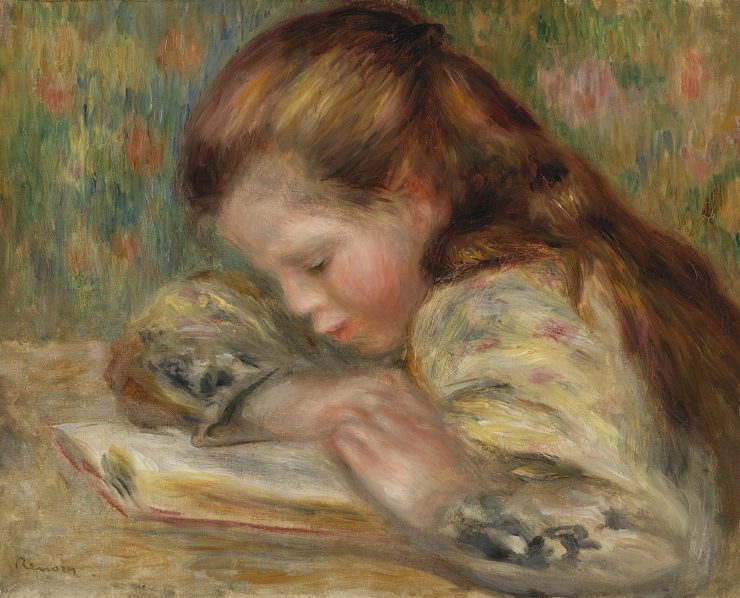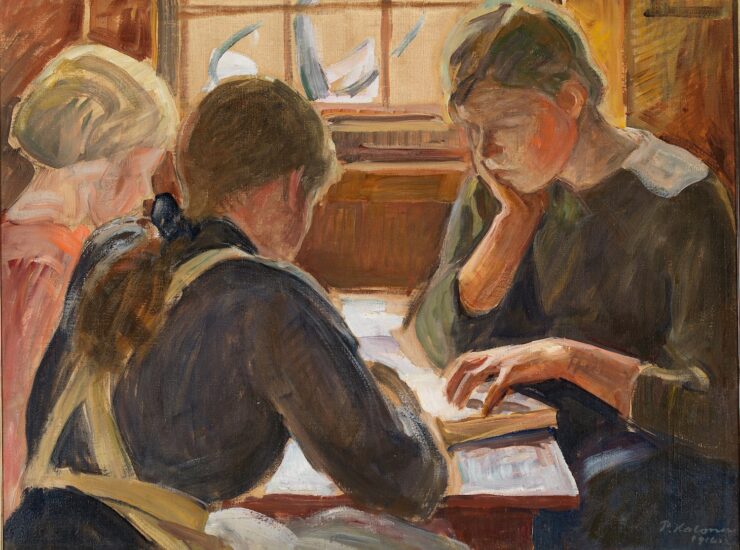There’s a book I love that no one else knows about. It caught my eye in the middle school library, magically shelved right in the spot of the fiction section where I liked to read, curled up safely in the corner. The cover was eerily appealing, with dandelions framing a three-faced figure. Her pointy faces looked angry. But the fox on the spine looked nice.
Some years later, I found a new copy of this book, Pat O’Shea’s The Hounds of the Morrigan, with a new cover: a gorgeous Kinuko Craft painting that I loved even though it didn’t look right to my young self’s memory of the book. The book isn’t lush and rich but spry and scrappy, a story about Pidge and his sister Brigit, about Cooroo the fox and magic candies and a lot more details that I remember disjointedly. A spider named Napoleon. Wanting the hounds to be nice. The cover wasn’t my cover, but I was still thrilled to see the book available again: Maybe someone else would read it!
I still only know one person who knows this story. I know there are other readers out there, but it feels like I love this one alone. Don’t you have a book like that? And isn’t it a weird feeling?
What I’m not sure about is why this feeling now seems so weird. I’ve said before that I didn’t know, for most of my life, that being a reader could be a thing, a hobby, a kind of fandom. Reading was just what I did in between climbing trees and riding my bike. As I got older, I had one friend who read what I read, fantasy novels passing between us while our classmates read true crime and thrillers. It wasn’t until my first job in children’s publishing that I was regularly around people who had read at least some of the same books as me—books we loved as kids, books we read for work, classics like The Book of Three and Over Sea, Under Stone and new loves like Garth Nix’s Old Kingdom series and M.T. Anderson’s Feed.
Reading is a solitary activity, but at some point it became more than that. I sought out like-minded people on LiveJournal, on Twitter, on websites and platforms long dead and gone; I made more bookish friends, worked in a bookstore, worked in publishing again. I recommended books to customers and colleagues and took their recommendations in turn, and somewhere along the line discovered the absolute glee that happens when two (or more) people who just really, really love a book start talking about it. That glee is contagious in the best possible way. It feels like it multiplies exponentially. It feels like it needs to be shared.
There are a lot of good (and many terrible) things about being online, but bookish community—any community that lets you have those moments of delight (and sometimes rage) with other people—is one of the good things. Sure, reading is solitary, but the full experience of a book doesn’t have to be. There are so many ways to find bookish connections now—with other readers, with the authors themselves, with essays and articles and blogs and even just a single tweet that gives you a new perspective on a long-loved book.
And so, the lost books, the ones no one seems to remember or never read, the authors that never reached the peak of commonality, at least in one’s own corner of the world—those feel ever more lonesome. It’s like they occupy space differently or vibrate at a different frequency in my mind. I know there are people out there who also adore The Hounds of the Morrigan, who would also give up a lot to be able to peek at O’Shea’s unfinished sequel. There are other Jo Clayton fans, readers who fell hard for a green girl named Serroi and the woman with the diadem on her head and all the many books that came after. I have still never met anyone else who’s even heard of Kathleen Sky’s Witchdame, but I know they’re out there too. Stormwarden? The Keeper of the Isis Light? I almost thought I dreamed that one until it got reissued a while back.
Buy the Book


Face
These are the books I buy whenever I find them on used shelves, ready with an extra copy to shove into a friend’s hand if she shows even the slightest bit of curiosity. I’ve done this enough times with Franny Billingsley’s Chime that I no longer feel alone in my love for it.
That is one of the more practical and proactive ways to find more readers of your most beloved, underappreciated books: find copies and give them to people. (Assuming you can find copies. Assuming they aren’t rare and haven’t been out of print for decades.) But don’t you want serendipity sometimes? That feeling of stumbling onto a copy of a book you forgot you’d been looking for—but instead, stumbling onto a person who also loves that book? There’s something fairy-tale-like about these books, overlooked, hidden right out in the open, our own copies coffee-stained and coverworn. Like they have secrets that you can’t discuss with someone else unless they say certain things first. Like just saying the title to the right other person is a kind of spell.
Online, there are some books around which huge communities have sprung up, massive, passionate fandoms trading fanart and the greatest Tumblr posts and quotes and fic and jokes and memes and dreamcasts. There are TV adaptations that turn years-old novels into bestsellers, until you can’t go anywhere without seeing somebody reading one of them, or spot a paperback abandoned on a subway seat. It’s exhilarating to see these things happen, to watch books fly into the pop culture stratosphere, brightly lit and reflected in a million shining eyes.
But some books—not unlike some readers—are wallflowers. The spotlight might still be nice. A little more glow, a few more pairs of eyes. A minor renaissance. But it’s comfortable over here in the corner, with a wall to lean on while we read. Don’t we all love some wallflowers? What are yours?
Molly Templeton lives and writes in Oregon, and spends as much time as possible in the woods. Sometimes she talks about books on Twitter.














